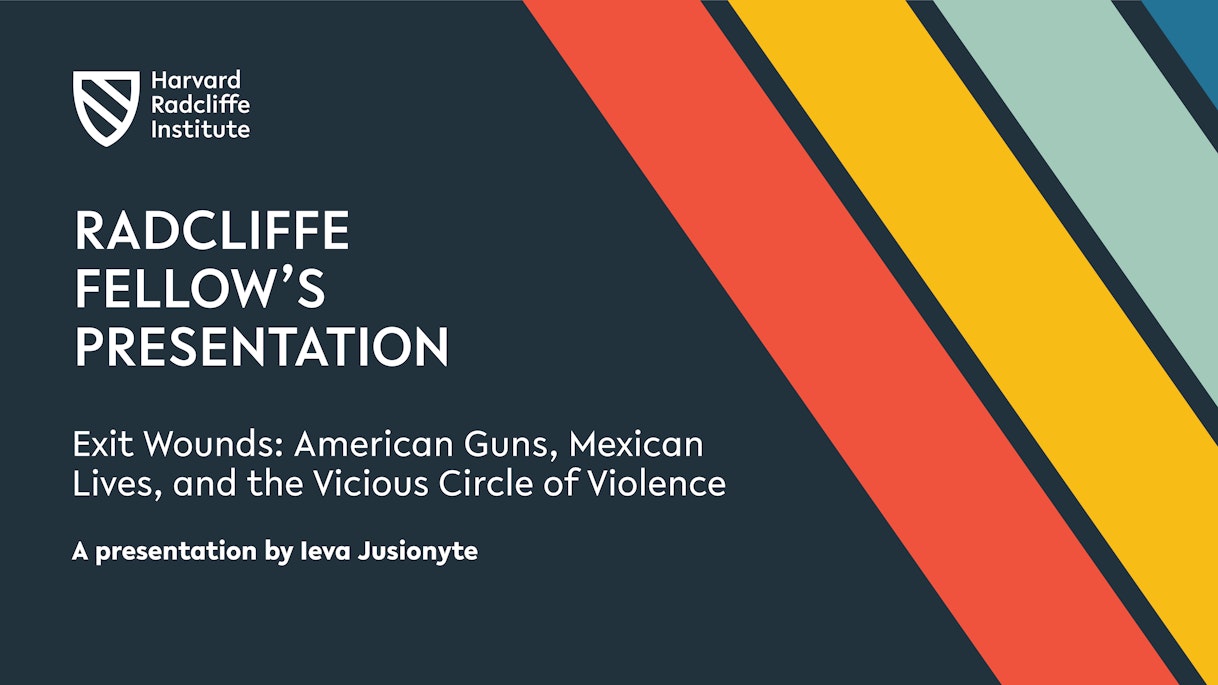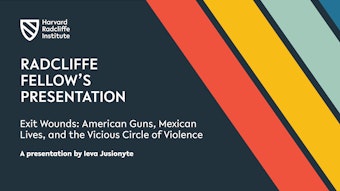Following the Guns South

Ieva Jusionyte, an anthropologist, embeds herself at the border to shed light on the illegal flow of guns from the United States into Mexico.
As she struggled to aim an AR-15, Ieva Jusionyte, Radcliffe’s 2022–2023 Maury Green Fellow, questioned the wisdom of her research project for the 100th time.
But to truly understand the massive flow of illegal guns from the United States into its southern neighbor, and its effects on communities on both sides of the border, she knew she needed to become familiar with a range of firearms and to get close to the organized crime groups using them. The hands-on approach has always been central to Jusionyte, an anthropologist and ethnographer whose work as an investigative journalist and emergency responder informed her earlier research on borders. This project would be no different.
She learned how to shoot a .22 caliber semiautomatic handgun at a gun safety course in Massachusetts while an assistant professor of anthropology and social studies at Harvard. The training came in handy with gun owners in Mexico who invited her to accompany them to target practice with AR-15s in 2019. Knowing how to handle a Kalashnikov, the high-powered military-style weapon of choice for many in organized crime, was more about caution. “To be safe around the kinds of guns the people I met used, I needed to know how they worked and how to unload them,” says Jusionyte.
During her interviews, the author and scholar made safety a priority. For some meetings with members of the Zetas, one of the country’s most dangerous crime syndicates that has splintered into smaller, equally violent groups, she worked with a journalist who had covered the organization for years and was part of a government protection program. She also trained in Krav Maga, the form of hand-to-hand combat developed by the Israeli Army, and let her family know what to do if she was kidnapped.
“There were times when I was scared,” says Jusionyte. “But this was a decision I made when I chose to follow the guns south.”
Her perseverance has paid off. At Radcliffe, Jusionyte is finishing her latest manuscript, “Exit Wounds: American Guns, Mexican Lives, and the Vicious Circle of Violence.” It chronicles her travels to the Mexican states of Nuevo León, Tamaulipas, and Coahuila, as well as to the US states of Arizona and Texas, where she lived and worked for months at a time from 2018 to 2019 interviewing government officials, federal agents, gun enthusiasts, and those involved in organized crime.
An associate professor of international security and anthropology at Brown University, Jusionyte’s book explores how the hundreds of thousands of American guns illegally smuggled into Mexico each year fuel extortion, corruption, drug trafficking, and other forms of violence.
“Many people running towards the border and seeking safety in the United States are fleeing violence that’s very much caused by US firearms,” she says. “And the Mexican citizens who decide to stay in their country have been arming themselves against organized crime groups because they know they can’t rely on Mexican security forces to protect them.”
For law-abiding Mexican citizens, buying guns illegally is often the most convenient option. Mexico’s only gun store is located on an army base in the nation’s capital, where it’s guarded by soldiers, and Mexican officials issue fewer than 50 gun permits per year. By contrast, the Bureau of Alcohol, Tobacco, and Firearms (ATF) listed more than 50,000 gun dealers in the United States in 2020, which includes gun and pawn shops, large chain stores such as Walmart, and individuals who are registered to sell at gun shows. And there have been more than 23 million firearm background checks initiated in 2022 in United States, according to the National Instant Criminal Background Check System.
The ATF also estimates that 70 percent of guns recovered in Mexico between 2014 and 2018 came from the United States. Today, the Mexican government wants US gun manufacturers to pay for the harm they say their weapons have caused. Last year, Mexico filed a $10 billion lawsuit against US gun companies, holding them responsible for the half million guns they argue are trafficked into Mexico from the United States each year. (Jusionyte suspects that number is closer to 200,000.) The suit was recently dismissed by a federal judge, but Mexican officials plan to appeal. The country filed another lawsuit last month against a group of gun dealers based in Arizona.

Jusionyte hopes her work will help people understand how the illicit gun trade devastates countless lives. Photo by Tony Rinaldo
Jusiontye says three key events have driven the spike in illegal gun trafficking and violence in Mexico over the past two decades. First, the political party that had run the country for 71 years, the Institutional Revolutionary Party, or PRI, lost its first national election in 2000, disrupting the “entrenched patronage” between government officials and crime bosses and escalating competition among organized crime networks. Then came the tightening of the US borders after 9/11, forcing drug suppliers to buy more guns to compete for fewer, less regulated smuggling routes. Finally, in 2004, Congress allowed the assault weapon ban to expire in the United Sates, fostering the proliferation of high-powered arms.
“All of these things came together,” says Jusionyte. “It was just perfect storm.”
But in addition to cataloguing how glaring policy failures, corruption, and weak gun laws in the United States drive “levels of violence exponentially due to the presence of these powerful guns from the United States,” Jusionyte weaves through the pages of her manuscript a deeply personal tale. She hopes her narrative, centered on those caught in a system of violence, will help readers understand how the illicit gun trade devastates countless lives and how many turn to guns for survival.
“For me, perhaps one of the biggest takeaways is just how difficult it is to distinguish between a victim of violence from the perpetrator of violence, because a lot of these people were victimized and then became perpetrators themselves.”
“Exit Wounds” is just the latest in a series of hands-on scholarly work by the author. While working as a journalist and researching her first book, Savage Frontier: Making News and Security on the Argentine Border (University of California Press, 2015), Jusionyte helped a local fire department rescue flood victims during a violent storm, an event that led her to become a certified emergency medical technician, paramedic, and wildland firefighter. In her book Threshold: Emergency Responders on the US–Mexico Border (University of California Press, 2018), Jusionyte drew on her volunteer efforts at a fire department in Arizona and a migrant aid center in Sonora, Mexico, to better understand how workers in both countries have experienced the security build-up along the border.
She sees her scholarship and her role as a volunteer EMT/paramedic as equally important in her efforts to make a difference. As she prepares to submit her manuscript, she is also busy making plans to head back to work at the migrant aid center on the border next summer.
“It’s not enough, not enough,” Jusionyte says, as her voice trails off. “I am going to do more.”
Colleen Walsh is a freelance writer.

Watch Ieva Jusionyte's fellow's talk, "Exit Wounds: American Guns, Mexican Lives, and the Vicious Circle of Violence."








